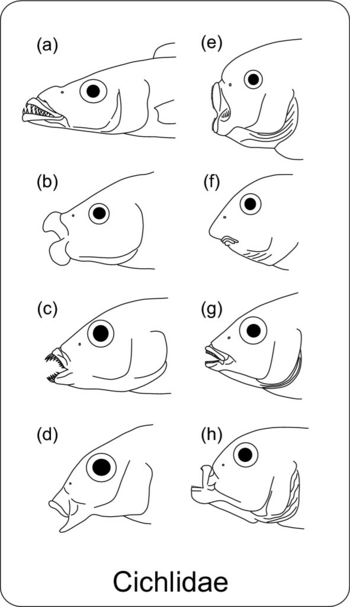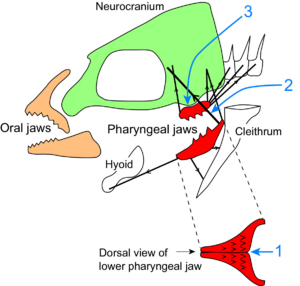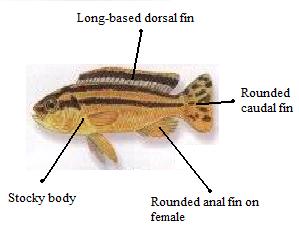Cichlids

Diversity of the skull in the Cichlidae. (a) Rhamphochromis macrophthalmus, a piscivore, (b) Haplochromis euchilus, a digger in sand, (c) Labidochromis vellicans, a picker of small arthropods, (d) Lethrinops brevis, a digger in sand, (e) Petrotilapia tridentiger, a rock scraper, (f) Labeotropheus fuelleborni, an algal-eating rock scraper, (g) Haplochromis similis, a leaf chopper, (h) Genyochromis mento, a scale eater.

Diagrammatic representation of the principal components of the specifically modified pharyngeal jaw apparatus of cichlids. Red elements are the upper and lower pharyngeal jaws. The muscles organizing the pharyngeal jaw apparatus are represented as black thick lines, and the principal directions of force have been indicated by arrows. Numbers indicate three major features of the specialized "labroid" pharyngeal jaw apparatus: 1) the left and right lower jaw elements are fused into a single structure, 2) the lower jaw is suspended in a muscular sling that runs from the neurocranium to the posterior muscular arms of the lower jaw, and 3) the upper jaw elements have a diarthrotic articulation with the underside of the neurocranium.
The 1,000 or more members of the cichlid family are native to Central and South America, Africa, Asia, and parts of the USA. Most will acclimatize well to domestic tap water, although some species, such as the discus fish, need carefully controlled water.
The colors, shapes, and sizes of cichlids vary enormously, although they tend to be heavily built. Some grow to large for the average community tank, while others breed readily among other fishes in any aquarium. Male cichlids from the Americas may have longer, more pointed dorsal and anal fins, while male African Rift Valley cichlids often have yellow or orange spots on the anal fin. There is plenty of opportunity for specialization within this family: Rift Valley cichlids, for example, prefer hard water and rocky furnishings. Many are herbivorous, requiring vegetable foods. Cichlids are hearty eaters and produce a lot of waste, which calls for frequent water changes. Generally these fishes reproduce by egg-depositing, but they display diverse methods of breeding, all of which involve a high degree of parental care.
